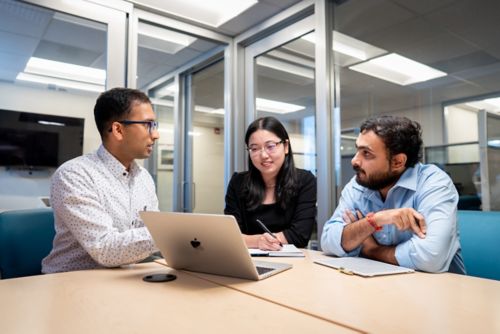St. Jude Family of Websites
Explore our cutting edge research, world-class patient care, career opportunities and more.
St. Jude Children's Research Hospital Home

- Fundraising
St. Jude Family of Websites
Explore our cutting edge research, world-class patient care, career opportunities and more.
St. Jude Children's Research Hospital Home

- Fundraising
Subodh Selukar Group
Provides statistical support and methodology development for rare population studies in pediatric cancer and high-risk non-malignant diseases.
About the group
Many pediatric cancers are characterized by rare populations and small study sample sizes, attributes that can preclude the use of standard statistical methodologies developed for larger patient populations, including adult oncology. These are particularly prevalent in the Selukar group’s collaborations with investigators from the St. Jude Department of Bone Marrow Transplantation & Cellular Therapy (SJ-BMTCT) and the Children’s Oncology Group’s Central Nervous System (COG-CNS) disease committee. Accordingly, the group specializes in statistical support and guidance in navigating research with small sample sizes that make traditional methodologies impractical in informing study design and conclusions within a reasonable timescale or preclude traditional analysis methods. The overarching goal of the Selukar group is to develop novel methodologies that address these challenges, with a special interest in cure-model based statistical approaches to analyze therapeutic efficacy in rare diseases.

Research summary
The Selukar group collaborates with faculty from the St. Jude Department of Bone Marrow Transplantation & Cellular Therapy (SJ-BMTCT) and the Children’s Oncology Group’s Central Nervous System (COG-CNS) disease committee. The group supports a broad spectrum of clinical trials that span early to later phases and a diversity of patient populations and treatment regimens. Rare diseases and small patient sample sizes are a unifying theme of these collaborations, characteristic of pediatric cancers and high-risk non-malignant diseases, in general. Under conditions of small patient population size and rare outcome events, conventional statistical approaches are frequently inadequate to lend robustness to data interpretation. The Selukar group therefore develops novel methodology to tackle these unique challenges inherent to rare disease studies. In collaborative efforts, the Selukar group provides statistical support through all phases of clinical trial implementation, spanning areas of trial design, monitoring, analysis, and manuscript preparation. The group also provides similar support for retrospective studies.
Small study sample sizes can complicate each component of study design, monitoring, and analysis, and the Selukar group has broad interest in addressing these challenges and improving methodology. Active research in this setting includes studying methodologies for time-to-event data analysis, safety and futility monitoring of accumulating data, jointly analyzing adverse event data with efficacy data, and incorporating external data for clinical trials.
A long-term research interest of the Selukar group is the continual development and potential application of cure model-based design for pediatric clinical trials. In rare disease population studies, collection of individual time-to-event type measurements are frequently difficult or costly to obtain, due to restrictions of sample size and extensive follow-up time that would be needed for traditional analyses of treatment efficacy. New statistical methods to analyze the efficacy of treatment are therefore necessary to more efficiently evaluate the success of a therapy and facilitate the design of timely clinical trials. Following the successes by St. Jude researchers and others, designs that explicitly account for “cured” patients (long-term survivors of their disease) become an attractive and real-world plausible alternative for pediatric oncology. By applying these specialized designs, the Selukar group aims to alleviate many of the challenges in data collection for rare population trials, to enable robust conclusions to be drawn given limited sample size and time constraints, and to better inform clinical practices.
Software
shinyCox
In collaboration with the Pounds group, we developed the shinyCox R package to visualize survival functions predicted by Cox models. This software supports non-statisticians to interrogate Cox model results beyond traditional tabular summaries. We believe shinyCox will be impactful in maximizing our use of available resources and to drive advances in precision oncology and similar fields.
Featured Publications
About Subodh Selukar

Dr. Subodh Selukar is an Assistant Member of the St. Jude Faculty and received his PhD in Biostatistics from the University of Washington, Seattle. At St. Jude, Dr. Selukar collaborates with faculty in the St. Jude Department of Bone Marrow Transplantation & Cellular Therapy (SJ-BMTCT) and the Children's Oncology Group's Central Nervous System (COG-CNS) disease committee, where he serves as faculty statistician for a multitude of pediatric cancer and high-risk non-malignant disease studies that span a wide range of pathologies. His individual research focus is on the development of statistical methodologies for evaluating efficacy of treatment in rare disease populations and outcome events. Beyond research, Dr. Selukar is involved in various educational efforts, including the St. Jude Graduate School of Biomedical Sciences and the St. Jude Biostatistics Internship.
Contact us
Subodh Selukar, PhD
Assistant Member, St. Jude Faculty
Department of Biostatistics
MS768, Room S2042
St. Jude Children's Research Hospital

Memphis, TN, 38105-3678 USA GET DIRECTIONS